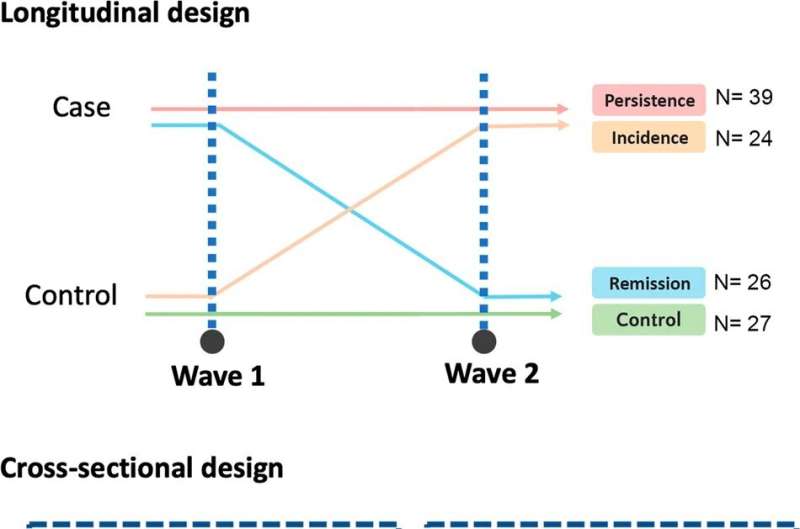This article has been reviewed according to Science X's editorial process and policies. Editors have highlighted the following attributes while ensuring the content's credibility:
fact-checked
peer-reviewed publication
trusted source
proofread
A method to access genetic information in blood samples and find correlations with mental health problems

Using blood samples to study diseases that originate in the brain is a difficulty faced by psychiatric genetics in the search for markers of mental health disorders. Researchers at the Federal University of São Paulo (UNIFESP) in Brazil have shown that this hindrance can be surmounted by analyzing microRNAs in extracellular vesicles (EVs), which are produced by most cells in the body, including neurons and other nervous system cells.
The study is published in the journal Translational Psychiatry.
Exosomes, the smallest type of EV, can cross the blood-brain barrier that protects the brain from pathogens and toxins. MicroRNAs (miRNAs) are small transcripts that target messenger RNAs and regulate the expression of several genes at once. They can be detected in biofluids and EVs and have been associated with mental disorders, including depression, anxiety, and attention deficit/hyperactivity disorder (ADHD), paving the way for early diagnosis and treatment in future.
"More work has to be done to validate these miRNAs, but our findings suggest genetic material from EVs can be identified non-invasively," said Jessica Honorato Mauer, first author of the article.
"We can't be absolutely sure the exosomes analyzed came from the brain, but we know they regulate gene expression in several types of tissue and may be involved in mechanisms that increase the risk of mental health disorders."
The study sample consisted of 116 participants in a study of psychiatric disorders in childhood (sometimes referred to by the acronym BHRCS, for Brazilian High-Risk Cohort Study). Two sets of blood samples were collected at time points three years apart (in adolescence and early adulthood). EVs were extracted from the blood serum and characterized. The researchers then sequenced miRNAs extracted from the EVs to analyze variations over time in search of associations with specific psychiatric disorders.
As part of this longitudinal analysis, they divided the participants into four groups according to disorder diagnosis and trajectory: a control group comprising those without a diagnosis at either time point; an "incidence" group comprising those who had no diagnosis at the first time point and then transited to a diagnosis; a "remission" group with a diagnosis only initially; and a "persistence" group with a diagnosis at both points.
Analysis of miRNAs from the four groups did not bring to light any statistically significant differences. Nevertheless, the results of the statistical tests can be used in future meta-analysis investigations.
A second analysis looked for associations between miRNAs and specific disorders at the same time point, comparing individuals diagnosed with depression, anxiety or ADHD versus those without any diagnosis. Expression of miR-328 was upregulated in children with ADHD compared with those without the disorder. For the second time point, miRNAs were found to be associated with depression and anxiety. Three of these (miR-432-5p, miR-151a-5p and miR-584-5p) were downregulated in subjects with anxiety, and five (miR-4433b-5p, miR-584-5p, miR-625-3p, miR-432-5p and miR-409-3p) in those with depression.
"We know there are no biomarkers for psychiatric disorders of the kind there are for certain diseases, such as cancer. I believe it will be possible in future to produce integrated predictions based on DNA, exosome miRNAs and interaction with the environment. In this case, for example, we'll be able to assess a person's genetic risk—the risk they were born with—and also evaluate the person over time by verifying changes in miRNAs or environmental exposures, so that treatment or interventions of other kinds can prevent the disease from becoming established in people who begin to present with changes in expression of this or that miRNA," said Marcos Leite Santoro, a professor of molecular biology at UNIFESP and last author of the article.
Next steps
The researchers plan to see if the results obtained hitherto can be confirmed for other cohort life stages, extending the study by using both existing data (available for more than 700 participants since 2010) and newly collected data on the same participants, who are now adults, and their children.
Besides miRNA expression, they also mean to analyze other types of data to glean a more integrated understanding of psychiatric disorders, including genomics, transcriptomics and DNA methylation, as well as environmental factors such as socio-economic conditions, exposure to drug abuse, ill-treatment in childhood, bullying at school and the COVID-19 pandemic.
More information: Jessica Honorato-Mauer et al, Alterations in microRNA of extracellular vesicles associated with major depression, attention-deficit/hyperactivity and anxiety disorders in adolescents, Translational Psychiatry (2023). DOI: 10.1038/s41398-023-02326-4


















